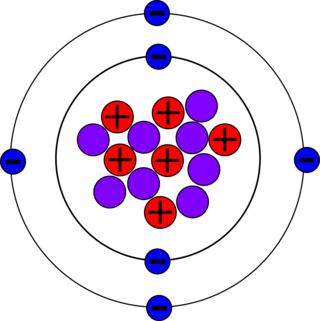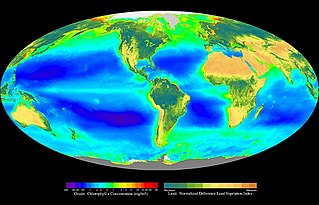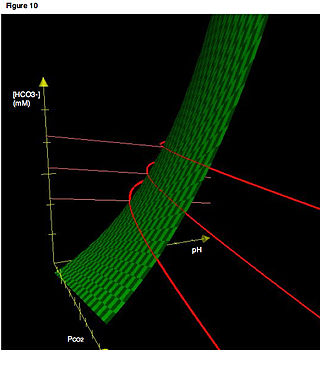Related Research Articles

Deuterium (hydrogen-2, symbol 2H or D, also known as heavy hydrogen) is one of two stable isotopes of hydrogen (the other is protium, or hydrogen-1). The deuterium nucleus, called a deuteron, contains one proton and one neutron, whereas the far more common protium has no neutrons in the nucleus. Deuterium has a natural abundance in Earth's oceans of about one atom of deuterium among every 6,420 atoms of hydrogen. Thus deuterium accounts for about 0.0156% by number (0.0312% by mass) of all hydrogen in the oceans: 4.85×1013 tonnes of deuterium – mainly in form of HOD (or 1HO2H or 1H2HO) and only rarely in form of D2O (or 2H2O) – in 1.4×1018 tonnes of water. The abundance of deuterium changes slightly from one kind of natural water to another (see Vienna Standard Mean Ocean Water).

Heavy water is a form of water whose hydrogen atoms are all deuterium rather than the common hydrogen-1 isotope that makes up most of the hydrogen in normal water. The presence of the heavier isotope gives the water different nuclear properties, and the increase in mass gives it slightly different physical and chemical properties when compared to normal water.

Carbon-14, C-14, 14
C or radiocarbon, is a radioactive isotope of carbon with an atomic nucleus containing 6 protons and 8 neutrons. Its presence in organic materials is the basis of the radiocarbon dating method pioneered by Willard Libby and colleagues (1949) to date archaeological, geological and hydrogeological samples. Carbon-14 was discovered on February 27, 1940, by Martin Kamen and Sam Ruben at the University of California Radiation Laboratory in Berkeley, California. Its existence had been suggested by Franz Kurie in 1934.

Isotope analysis is the identification of isotopic signature, abundance of certain stable isotopes of chemical elements within organic and inorganic compounds. Isotopic analysis can be used to understand the flow of energy through a food web, to reconstruct past environmental and climatic conditions, to investigate human and animal diets, for food authentification, and a variety of other physical, geological, palaeontological and chemical processes. Stable isotope ratios are measured using mass spectrometry, which separates the different isotopes of an element on the basis of their mass-to-charge ratio.

In ecology, primary production is the synthesis of organic compounds from atmospheric or aqueous carbon dioxide. It principally occurs through the process of photosynthesis, which uses light as its source of energy, but it also occurs through chemosynthesis, which uses the oxidation or reduction of inorganic chemical compounds as its source of energy. Almost all life on Earth relies directly or indirectly on primary production. The organisms responsible for primary production are known as primary producers or autotrophs, and form the base of the food chain. In terrestrial ecoregions, these are mainly plants, while in aquatic ecoregions algae predominate in this role. Ecologists distinguish primary production as either net or gross, the former accounting for losses to processes such as cellular respiration, the latter not.

An arterial blood gas (ABG) test, or arterial blood gas analysis (ABGA) measures the amounts of arterial gases, such as oxygen and carbon dioxide. An ABG test requires that a small volume of blood be drawn from the radial artery with a syringe and a thin needle, but sometimes the femoral artery in the groin or another site is used. The blood can also be drawn from an arterial catheter.
A radioactive tracer, radiotracer, or radioactive label is a synthetic derivative of a natural compound in which one or more atoms have been replaced by a radionuclide. By virtue of its radioactive decay, it can be used to explore the mechanism of chemical reactions by tracing the path that the radioisotope follows from reactants to products. Radiolabeling or radiotracing is thus the radioactive form of isotopic labeling. In biological contexts, experiments that use radioisotope tracers are sometimes called radioisotope feeding experiments.
Vienna Standard Mean Ocean Water (VSMOW) is an isotopic standard for water, that is, a particular sample of water whose proportions of different isotopes of hydrogen and oxygen are accurately known. VSMOW is distilled from ocean water and does not contain salt or other impurities. Published and distributed by the Vienna-based International Atomic Energy Agency in 1968, the standard and its essentially identical successor, VSMOW2, continue to be used as a reference material.
Isotopic labeling is a technique used to track the passage of an isotope through chemical reaction, metabolic pathway, or a biological cell. The reactant is 'labeled' by replacing one or more specific atoms with their isotopes. The reactant is then allowed to undergo the reaction. The position of the isotopes in the products is measured to determine what sequence the isotopic atom followed in the reaction or the cell's metabolic pathway. The nuclides used in isotopic labeling may be stable nuclides or radionuclides. In the latter case, the labeling is called radiolabeling.
In chemistry, isotopologues are molecules that differ only in their isotopic composition. They have the same chemical formula and bonding arrangement of atoms, but at least one atom has a different number of neutrons than the parent.

Oxygen isotope ratio cycles are cyclical variations in the ratio of the abundance of oxygen with an atomic mass of 18 to the abundance of oxygen with an atomic mass of 16 present in some substances, such as polar ice or calcite in ocean core samples, measured with the isotope fractionation. The ratio is linked to ancient ocean temperature which in turn reflects ancient climate. Cycles in the ratio mirror climate changes in the geological history of Earth.

Isotope-ratio mass spectrometry (IRMS) is a specialization of mass spectrometry, in which mass spectrometric methods are used to measure the relative abundance of isotopes in a given sample.
The respiratory quotient is a dimensionless number used in calculations of basal metabolic rate (BMR) when estimated from carbon dioxide production. It is calculated from the ratio of carbon dioxide produced by the body to oxygen consumed by the body. Such measurements, like measurements of oxygen uptake, are forms of indirect calorimetry. It is measured using a respirometer. The respiratory quotient value indicates which macronutrients are being metabolized, as different energy pathways are used for fats, carbohydrates, and proteins. If metabolism consists solely of lipids, the respiratory quotient is approximately 0.7, for proteins it is approximately 0.8, and for carbohydrates it is 1.0. Most of the time, however, energy consumption is composed of both fats and carbohydrates. The approximate respiratory quotient of a mixed diet is 0.8. Some of the other factors that may affect the respiratory quotient are energy balance, circulating insulin, and insulin sensitivity.

Soil respiration refers to the production of carbon dioxide when soil organisms respire. This includes respiration of plant roots, the rhizosphere, microbes and fauna.

John Roger Speakman is a British biologist working at the University of Aberdeen, Institute of Biological and Environmental Sciences, for which he was Director from 2007 to 2011. He leads the University's Energetics Research Group, which is one of the world's leading groups using doubly labeled water (DLW) to investigate energy expenditure and balance in animals. Between 2011-2020, he was a '1000 talents' Professor at the Institute of Genetics and Developmental Biology, Chinese Academy of Sciences, in Beijing, China, where he ran the molecular energetics group. In 2020 he moved to the Shenzhen Institutes of Advanced Technology, Chinese Academy of Sciences in Shenzhen, China where he works at the Center for Energy Metabolism and Reproduction and Head of the Shenzhen Key laboratory of Metabolic Health.
Field metabolic rate (FMR) refers to a measurement of the metabolic rate of a free-living animal.

Indirect calorimetry calculates heat that living organisms produce by measuring either their production of carbon dioxide and nitrogen waste, or from their consumption of oxygen. Indirect calorimetry estimates the type and rate of substrate utilization and energy metabolism in vivo starting from gas exchange measurements. This technique provides unique information, is noninvasive, and can be advantageously combined with other experimental methods to investigate numerous aspects of nutrient assimilation, thermogenesis, the energetics of physical exercise, and the pathogenesis of metabolic diseases.
Clumped isotopes are heavy isotopes that are bonded to other heavy isotopes. The relative abundance of clumped isotopes (and multiply-substituted isotopologues) in molecules such as methane, nitrous oxide, and carbonate is an area of active investigation. The carbonate clumped-isotope thermometer, or "13C–18O order/disorder carbonate thermometer", is a new approach for paleoclimate reconstruction, based on the temperature dependence of the clumping of 13C and 18O into bonds within the carbonate mineral lattice. This approach has the advantage that the 18O ratio in water is not necessary (different from the δ18O approach), but for precise paleotemperature estimation, it also needs very large and uncontaminated samples, long analytical runs, and extensive replication. Commonly used sample sources for paleoclimatological work include corals, otoliths, gastropods, tufa, bivalves, and foraminifera. Results are usually expressed as Δ47 (said as "cap 47"), which is the deviation of the ratio of isotopologues of CO2 with a molecular weight of 47 to those with a weight of 44 from the ratio expected if they were randomly distributed.
Hydrogen isotope biogeochemistry is the scientific study of biological, geological, and chemical processes in the environment using the distribution and relative abundance of hydrogen isotopes. There are two stable isotopes of hydrogen, protium 1H and deuterium 2H, which vary in relative abundance on the order of hundreds of permil. The ratio between these two species can be called the hydrogen isotopic signature of a substance. Understanding isotopic fingerprints and the sources of fractionation that lead to variation between them can be applied to address a diverse array of questions ranging from ecology and hydrology to geochemistry and paleoclimate reconstructions. Since specialized techniques are required to measure natural hydrogen isotope abundance ratios, the field of hydrogen isotope biogeochemistry provides uniquely specialized tools to more traditional fields like ecology and geochemistry.

Position-specific isotope analysis, also called site-specific isotope analysis, is a branch of isotope analysis aimed at determining the isotopic composition of a particular atom position in a molecule. Isotopes are elemental variants with different numbers of neutrons in their nuclei, thereby having different atomic masses. Isotopes are found in varying natural abundances depending on the element; their abundances in specific compounds can vary from random distributions due to environmental conditions that act on the mass variations differently. These differences in abundances are called "fractionations," which are characterized via stable isotope analysis.
References
- ↑ Lifson, N., Gordon, G.B. and McClintock, R. (1955) Measurement of total carbon dioxide production by means of D218O. J. Appl. Physiol., 7, 704–710.
- ↑ Lifson, N. and McClintock R. (1966) Theory of use of the turnover rates of body water for measuring energy and material balance. J. Theor. Biol., 12, 46–74.
- ↑ Speakman JR (October 1998). "The history and theory of the doubly labeled water technique". Am. J. Clin. Nutr. 68 (4): 932S–938S. doi: 10.1093/ajcn/68.4.932S . PMID 9771875.
- ↑ Schoeller, D.A. and van Santen, E. (1982) Measurement of energy expenditure in humans by doubly labelled water. J. Appl. Physiol., 53, 955–959.
- ↑ Speakman, J.R., Doubly Labelled Water: Theory and Practice. Springer Scientific publishers. ISBN 0-412-63780-4 ISBN 978-0412637803, 416 pages)
- ↑ Westerterp, Klaas R. (2017). "Doubly labelled water assessment of energy expenditure: principle, practice, and promise". European Journal of Applied Physiology. 117 (7): 1277–1285. doi:10.1007/s00421-017-3641-x. ISSN 1439-6319. PMC 5486561 . PMID 28508113.
- ↑ Lifson, N., Gordon, G.B., Visscher, M.B. and Nier, A.O. (1949) The fate of utilized molecular oxygen and the source of the oxygen of respiratory carbon dioxide, studied with the aid of heavy oxygen. J. Biol. Chem. A, 180, 803–811.
- ↑ Jones PJ, Winthrop AL, Schoeller DA, et al. (March 1987). "Validation of doubly labeled water for assessing energy expenditure in infants". Pediatr. Res. 21 (3): 242–6. doi: 10.1203/00006450-198703000-00007 . PMID 3104873.
- ↑ Heini A, Schutz Y, Diaz E, Prentice AM, Whitehead RG, Jéquier E (July 1991). "Free-living energy expenditure measured by two independent techniques in pregnant and nonpregnant Gambian women". Am. J. Physiol. 261 (1 Pt 1): E9–17. doi:10.1152/ajpendo.1991.261.1.E9. PMID 1858878.
- ↑ Speakman, JR (2000) The cost of living: Field metabolic rates of small mammals. Advances in Ecological Research 30: 177–297
- ↑ Nagy, KA (2005) Field metabolic rates and body size. Journal of Experimental Biology 208, 1621–1625.
- ↑ Pontzer H, Yamada Y, Sagayama H, et al. (Aug 2021). "Daily energy expenditure through the human life course". Science. 373 (6556): 808–812. Bibcode:2021Sci...373..808P. doi:10.1126/science.abe5017. PMC 8370708 . PMID 34385400.
- ↑ Steckel, F.; Szapiro, S. (4 July 1962). "Physical properties of heavy oxygen water. Part 1.—Density and thermal expansion". Transactions of the Faraday Society. 59: 331–343. doi:10.1039/TF9635900331.